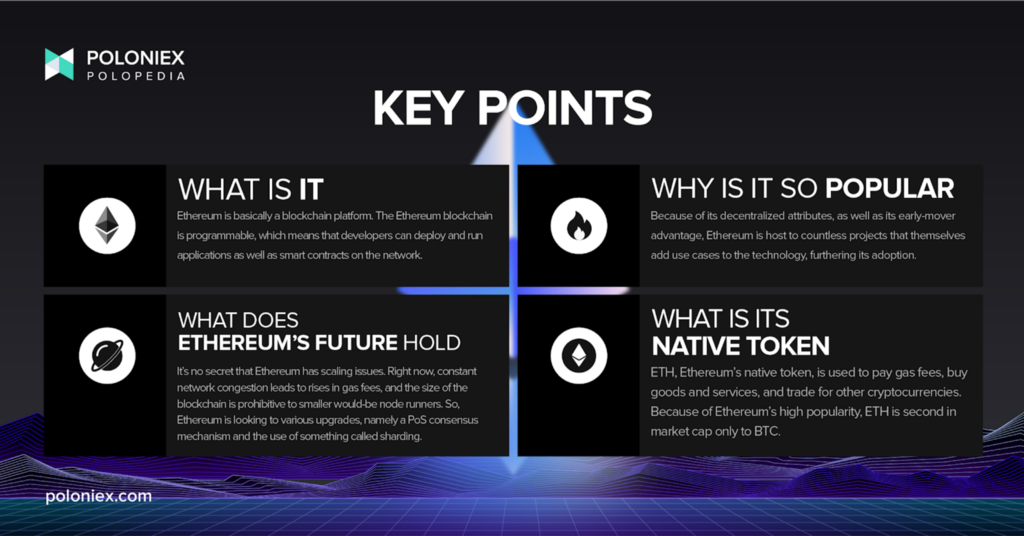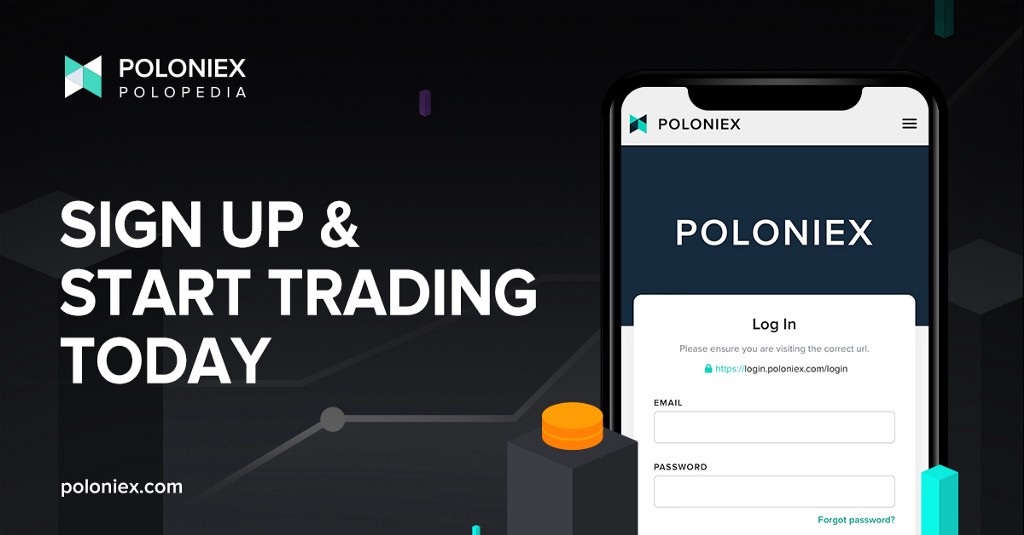What Ethereum is, in short (TL;DR)
Ethereum is basically a blockchain-based state machine that gives developers tools to deploy smart contracts and their own project tokens. Its blockchain is programmable, meaning this state machine, or computer if you like, can perform a range of tasks. These tasks are defined in things called smart contracts, which we’ll go into below. And because of this programmability, developers can deploy and operate applications on Ethereum. And since its founding, it has blossomed into a full ecosystem of dApps (decentralized applications) that include applications like NFT marketplaces, metaverse platforms, and many more DeFi applications.

Smart contracts
We’ll dive into this further in a future article, but a smart contract is basically a trustless, digital version of a traditional contract. By executing code when certain pre-conditions are met, these smart contracts are able to be used without the need for both parties to trust that either side will follow through with their respective agreements.
Trustlessness is often the name of the game in blockchain, and smart contracts have been the main driver pushing that ethos forward. They are what enable dApps (decentralized applications), NFTs, the metaverse, and so many other blockchain use cases.
The Ethereum Virtual Machine
The Ethereum Virtual Machine, or EVM, is what defines the rules for the Ethereum network to change and function. It is a software platform on which developers can create dApps. Because of its mass adoption by dApp developers, it is often seen as a prerequisite for projects to be “EVM-compatible” in order to attract developers.
Use Cases
Ethereum has proven quite useful for developers looking to deploy dApps and smart contracts. And because it is a popular place for projects, it is also host to many, many Ethereum-based project tokens. But the applications don’t stop there:
DeFi
Due to its decentralized nature and popularity among developers, Ethereum is often the first choice for DeFi applications. Not only this, but Ethereum uses Solidity, a programming language for the Ethereum Virtual Machine that is very beginner friendly. This has made the network all the more accessible to DeFi projects.
And because programs must be EVM-compatible to function on Ethereum, they all speak the same language, which makes for easy communication and integration with each other.
Digital IDs
As online social interaction matures and the world begins to look at more robust versions of social media such as the metaverse, having a secure digital identity will become ever more important for users. Soon, your digital identity may be tied to digital wallets that contain not only crypto, but non-fungible digital assets as well.
Because Ethereum is programmable, it can handle digital credentials via an Ethereum address. Users can utilize this when accessing programs across Web3, and hopefully in the future, across existing Web2 applications as well. Of course, the value of using an Ethereum address lies in the security of its blockchain.
NFTs
When talking about Ethereum and NFTs (non-fungible tokens), we must first talk about how the network facilitates the building of these tokens. ERC-721, the protocol designed for NFTs, differentiates itself from the ERC-20 protocol by being able to describe qualitative aspects, so describing a unique asset, rather than quantitative aspects, which helps describe the amount and value of a cryptocurrency, or something fungible. ERC-721, in short, makes NFTs possible. And because applications on Ethereum have the same backend, transferring NFTs is quite seamless.
The metaverse
Ohhh, the metaverse, one of the latest hot topics of the crypto world. The traversable, digital analog for our own world has been the object of interest of many a company, both crypto-native and tech-incumbent. And it has, in large part, become what it is due to the Ethereum blockchain. The dApps and NFTs that are present in these worlds are often deployed on Ethereum.
By the way, we have an explainer article that does a deeper dive into the metaverse. Check that out to learn more about what may very well be the future of online communication: https://medium.com/poloniex/to-the-metaverse-and-beyond-ecd3dcd19a33
DAOs
A DAO, or Decentralized Autonomous Organization, is an organization that functions on computer-enforced rules via a smart contract and features a treasury overseen by the non-hierarchical organization of its members.
The thesis of a DAO is decentralization (it is in the name, after all!), so Ethereum’s decentralized characteristics and smart contract capabilities make it a prime system on which to operate a DAO.
Gas and Ethereum’s Scaling Issues
Now, we can’t talk about Ethereum without talking about gas. Network fees, dubbed “gas fees”, are what users have to pay to blockchain validators for transactions on the blockchain. Ethereum’s network, as of right now, utilizes a Proof-of-Work consensus mechanism, which has a very low throughput for transactions: 15TPS.
Of course, there are only so many validators, and because of Ethereum’s popularity, its network is often congested. Where things get expensive is that users can opt to pay more gas to get priority for validation. And so comes the bidding war, driving up the gas price and making getting anything done on the network, especially during times of high-traffic, a quite expensive endeavor.
This, everyone, is one of Ethereum’s main scaling problems. So, what is Ethereum to do? What does its future look like? 👀⬇️
The Future of Ethereum
The Beacon Chain
Before we get into things, it is important to note that this upgrade to Ethereum’s consensus layer has been referred to as ‘Eth2’. However, this term is being “phased out”, according to Ethereum in its article covering technology upgrades. The Beacon Chain, which will be the consensus layer of the Ethereum network and does away with the computationally laborious Proof-of-Work mechanism, has been hailed by many as a solution to Ethereum’s scaling problem.
The upgrade event, known as “The Merge”, will be the point at which the Beacon Chain, Ethereum’s PoS consensus layer, merges with its mainnet.
Not only will this new consensus layer help with Ethereum’s congestion and overall usability, it is also more environmentally friendly, as it does not require large, energy-consuming hardware to operate.
Sharding
Sharding, which refers to the splitting of a dataset across multiple databases, is something that is looked at as part of the solution to the network’s scaling and congestion problems. With sharding, Ethereum’s database of accounts and smart contracts can be split into smaller chains. This means that nodes, which verify new transactions and produce new blocks, aren’t responsible for keeping a record of every single change in state. By further decentralizing this job, the network is less vulnerable to centralization, and the verification process becomes more accessible. Right now, because nodes must keep a full copy of the Ethereum ledger, it takes a lot of computing power to do the work, which is very prohibitive. With sharding, one might even be able to become a validator with just their personal computer.
What can you do with ETH
ETH is the native cryptocurrency of the Ethereum network. Like with other tokens, you can use ETH to pay for various products or services as well as trade it for other cryptocurrencies. Users also use ETH to pay transaction fees on the network, often referred to as gas fees.
How to buy ETH
You can get ETH on multiple exchanges like Poloniex! ETH can be acquired through trades on our ETH trading market or through buying directly with your debit or credit card.

Feeling ready to get started? Sign-up is easy! Just hop on over to https://poloniex.com/signup/ to start your crypto journey🚀
was originally published in The Poloniex blog on Medium, where people are continuing the conversation by highlighting and responding to this story.

